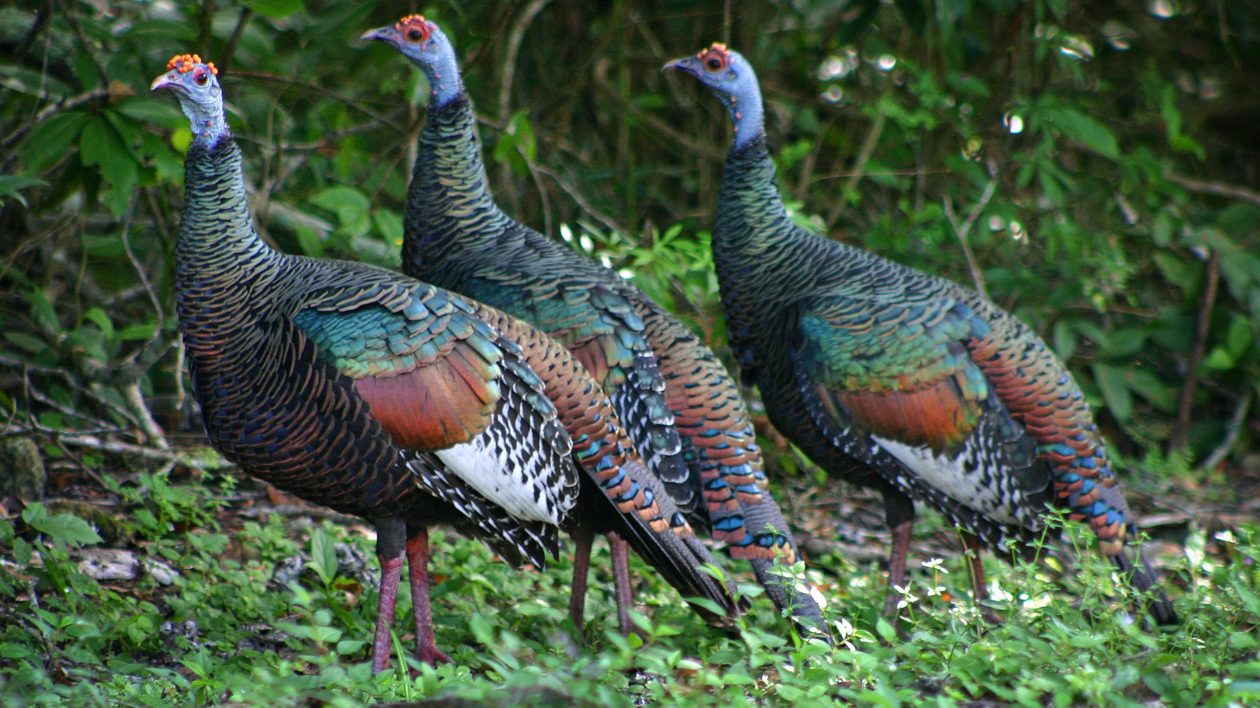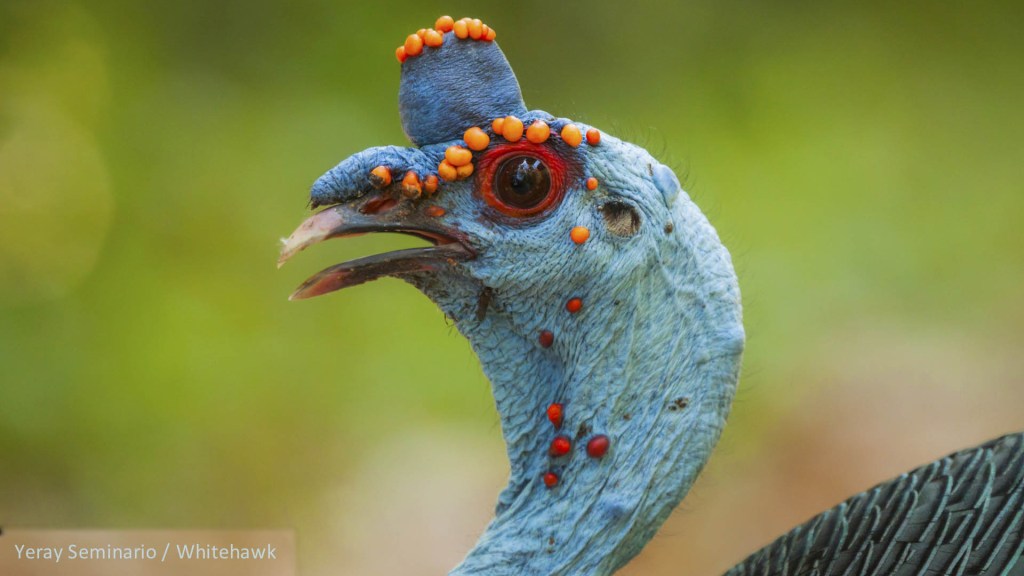I know: turkeys are hard to avoid this week. Some 45 million will be served on Thanksgiving Day across the United States, to say nothing of turkey decorations, turkey trivia and turkey pardons.
Let’s put thoughts of that turkey aside for a moment, because there is another turkey species, this one arguably even more spectacular than the wild and domestic bird (yes, they’re the same species, Meleagris gallopavo) so common across North America.
Meet the ocellated turkey.
Found only on the Yucatan Peninsula of Mexico, Guatemala and Belize, the ocellated turkey (Meleagris ocellata) certainly bears a resemblance to the American wild turkey.
But it’s a different species. It is smaller and lacks the “beard” typical of the more familiar wild turkey. Its mating call is higher pitched than the usual “gobble.” The most striking difference, though, is the color.
The vibrant, almost unreal color: iridescent feathers, large spots on the tail, a bright red ring around the eye and a blue head covered with red and yellow nodules (nodules that swell and become brighter in males during the breeding season).
It’s a turkey as conceived by Dr. Seuss. Or perhaps Alexis Rockman.
Science writer Darren Naish, a fellow gamebird enthusiast, has the definitive blog on the ocellated turkey’s natural history and evolution.
Despite Naish’s excellent information, it is striking how little we know about this beautiful bird, especially information critical for its conservation.
As ornithologists with the Cornell Lab of Ornithology’s Neotropical Birds program note:
The current conservation status of this species should be interpreted recognizing the paucity of research on population levels, especially in habitat strata inaccessible to humans. Additionally, published research is often based on observational data from birds inhabiting protected areas that are habituated to humans and may not be representative of wild counterparts.

Most conservationists consider it near-threatened, with deforestation making the birds easier to kill by local subsistence hunters, a major factor in the species’ decline.
Many conservation organizations, including The Nature Conservancy, are working on protected areas in the Yucatan Peninsula.
There is at least anecdotal evidence that reserves could work well for ocellated turkey preservation. The heavily-visited Mayan ruins, like Tikal in Guatemala, are known by many birders and biologists to be the best places to observe these birds. These archaeological reserves are well guarded against looters and also have the regular presence of visitors that keep poachers away.
But protected areas also must benefit local people so they are not forced to poach turkeys. While some conservationists find it distasteful to attach dollar values to wild animals, when birders and sport hunters provide income to local communities, it provides an incentive to manage the turkeys sustainably.
The American wild turkey’s restoration is one of the most successful conservation efforts ever. Could we duplicate that success with the ocellated turkey? Only if people know the bird and care about its fate. So this Thanksgiving, don’t forget the “other” turkey, that colorful, striking bird of the Yucatan forest.
Special thanks to Yeray Seminario of whitehawkbirding.com for permission to use the striking photo of the male ocellated turkey featured in this blog.




Do any zoos or game bird breeders have ocellated turkeys in the U.S. or elsewhere? I have raised other subspecies of wild turkeys for conservation purposes and would dearly love to develop a flock of these also. Can anyone give me the name and email of someone to contact in an area where the birds are not endangered yet?
Hi Louis,
I have not seen them in zoos or have heard any instances of them being raised on game farms. There may be instances where they are being reared but I do not know of any. Many game birds are actually quite tough to rear in captivity.
Best,
Matt Miller
Beautiful birds! Several years ago – a large flock of turkeys discovered my birdfeeders! They became quite tame – stayed around for a couple years – but after that, stopped seeing any at all. Sorry to say that as with most wildlife – allowing them to become acclimated probably was the cause of their being hunted & GONE! I know there are turkeys in the area – ;have seen them on side roads not far away (live in the country). Really enjoyed them being around. I know for a fact they are still close by – hear them in the woods behind me. I imagine they now get the advantage of the bird feed without the disadvantage of the interfering human.
Cool! thanks man! 😀
Morning.
This is my 3rd year trying to breeds my Ocellated Turkeys One Male 2 femails. Problem being there eating their eggs. I tried incubator but no success.
I could try again, but where I live the electricity is on and off all the time. But definitely an option.
Looking for a broody duck or chicken. (This option worked once with 2 chicks. But never lasted due to human error)
Have tried separating the male. I thought he was eating them. But it was not him.
Have taken the 4 eggs out today. Not to loose anymore.
Any suggestions? Thanks in advance. Going insane!
Hi Tanya, You might try this forum on raising backyard chickens – it looks like people have discussed ocellated turkey breeding there in the past: https://www.backyardchickens.com/threads/ocellated-turkeys.824750/
I am in awe of the information about the ocellated turkey. I have often marveled at the beauty of the wild turkeys that live in my woods. The ocellated looks so much like mine but the colors are magnificent. I hope fate will be kind and this bird will live on & on.
Hi
Can ocellated turkey’s interbred with north american wild turkeys? If so, can the offspring produce fertile eggs?
Thanks for an answer, Dean
Hi I´m from Brazil.
Somebody knows where I can buy them ?
If anyone knows any information could email me please.
AGROBETEL@AGROBETEL.COM.BR
I want to make a habitat to preserve and perpetuate their species.
Thanks for all!
Love turkeys. It’s one of the best reason to look for forward for thanksgiving.
wow! what color, fascinating! Thanks for sharing!
Cool bird … love all those extra jewell like “eyes” … a bunch of turkey hunters look on this as the holy grail of turkey’s and definitely contribute $ to the local economies.